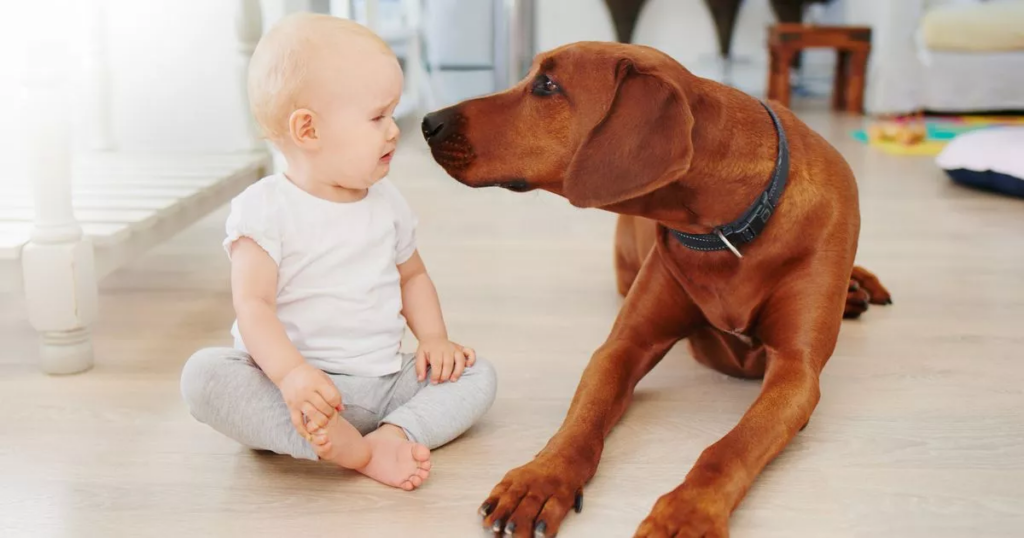Canine behaviourist Jacqui Zakar is educating parents on TikTok about the warning signs their dog is ‘resource guarding’ their baby and advising how to stop it before someone gets hurt
A dog behaviourist is educating parents about the warning signs of 'resource guarding' in dogs – a behaviour that could put their baby's life at risk.
Resource guarding is when a dog becomes defensive of a particular item they value.
They can exhibit aggressive actions, such as growling, flashing their teeth or biting.
People often mistake these warning signs for protectiveness, and assume their dog is positively safeguarding the baby – when really it's the opposite.
In a series of TikTok videos, accredited canine trainer Jacqui Zakar explains why resource guarding is dangerous and how you can stop it before someone gets hurt.
Sign up to our TeamDogs newsletter for your weekly dose of dog news, pictures and stories.
In one video on her TikTok account @dogsense, Jacqui shared a clip of a dog growling and guarding a baby, with the caption: "When the dog thinks he's the dad now."
Jacqui said: "We think the dog is being protective. This dog is aggressively warning his own owner to stay away from their own child.
"What reason does a dog have to guard a baby from its own parent? This is a behavioural issue. It's not protection. It's nothing to do with the baby's safety."
In another video, Jacqui highlights the signs that a pet is resource guarding, such as stress, panting, tongue flicking and posturing.
She explains that it can be brought on by a numbers of reasons, including lack of training, lack of boundaries and dogs that lack confidence.
"Some dogs will have more of an innate drive to guard things – food, toys, space, water, their owners and babies," Jacqui explained.
"A dog that resource guards its owner is often mistaken as protection, but confident, secure dogs don't need to guard their owners."
TikTok users praised Jacqui for addressing the issue.
One person agreed: "My dog did this when he was older. He attacked my older son and a friend's dog. It's definitely a behaviour issue, don't ignore as cute!"
Another said: "As a dog trainer I always preach about this type of behaviour! Thank you for this."
Rhiannon, a canine behaviourist at Battersea, describes resource guarding as: "When a dog becomes defensive in order to keep you away from a particular item or 'resource' that they treasure
"The resource can be food, treats, toys, a place, like a bed or favourite chair, or occasionally even a person.
"Resource guarding is a natural behaviour for your dog, and an important survival strategy as a scavenger in the wild, but at home there are some things we can do to reassure our dogs and let them know they don't need to become defensive."
Prevention is always better than cure, so it's a good idea to train your dog before resource guarding even begins.
Rhiannon explains: "To start, you will need some treats. The trick is to teach your dog that a person approaching is a positive thing.
"As your dog is finishing a meal, approach close to where they are eating, drop some treats near to their food bowl and calmly move away.
"Allow your dog to eat the treats and then return to finishing what is in their bowl. Repeat this a couple of times over a few days, always moving away and allowing your dog to eat the treats.
"Over time you may see that as you approach your dog, they look up as they anticipate a treat arriving. This is a positive sign that they see you approaching as a good thing.
"Approaching and rewarding will show your dog that someone coming close to them is a positive thing."
If your dog is already showing some signs of resource guarding behaviour, it's important to stop this from becoming any worse. Rhiannon advised the following:
Do you have a dog story to sell? Email nia.dalton@reachplc.com.
Calling all dog lovers! Sign up to TeamDogs for your weekly dose of dog news, pictures and stories.

